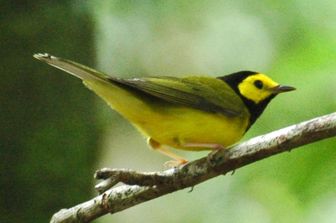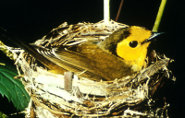Hooded Warbler
The Hooded Warbler has a plain olive/green-brown back, and yellow underparts. Their outer rectrices have whitish vanes. Males have black hoods which surround their yellow faces; the female has an olive-green cap which does not extend to the forehead, ears and throat instead. Males attain their hood at about 9–12 months of age; younger birds are essentially identical to females. The song is a series of musical notes which sound like: wheeta wheeta whee-tee-oh, for which a common pneumonic is The red, The red T-shirt. The call of these birds is a loud chip.

Original source: Hooded Warbler
Author: The Lilac Breasted Roller from Sullivan's Island, United StatesPermission(Reusing this file)This file is licensed under the Creative Commons Attribution 2.0 Generic license.You are free:to share – to copy, distribute and transmit the work
The Hooded Warbler - A Striking Black And Yellow Fellow
 The Hooded Warbler (Wilsonia citrina) is a small migratory songbird endemic to eastern North America. It is most commonly found in the United States east of the Mississippi River, north to Rhode Island, and all along the Gulf Coast during the summer breeding season. Small Canadian populations exist in southern Ontario, and winter migration brings them farther south into Central America and a few Caribbean islands.
The Hooded Warbler (Wilsonia citrina) is a small migratory songbird endemic to eastern North America. It is most commonly found in the United States east of the Mississippi River, north to Rhode Island, and all along the Gulf Coast during the summer breeding season. Small Canadian populations exist in southern Ontario, and winter migration brings them farther south into Central America and a few Caribbean islands.
Adult Hooded Warblers of both sexes weigh about 9-12 grams (0.3-0.4 ounces) and are about 13 centimeters (5.1 inches) in length. Their underparts are yellow, while their wings, tail, and back are olive green in color. There is sometimes white spotting in the tail, and they have short black beaks. The male sports a solid black hood and bib around his bright yellow face that exhibits a striking contrast and gives the bird its name. Females may also display hoods of varying development, but often lack one completely.
In their breeding range, Hooded Warblers nest in mature forests of deciduous and mixed vegetation, southern cypress swamps, and ravines. The females prefers low-lying areas of underbrush and scrub in which to build their nests, which they make from plant material, bark, and dead leaves. They will lay 3 to 5 eggs between April and July, which will hatch after about 12 days of incubation, and within 9 days the chicks will have fledged.
Hooded Warblers of both sexes sing a short, shrill, patterned song to attract mates. Although a female may pair with one male during mating season, her eggs may end up being fertilized by a different male. Hooded Warblers are also very territorial, and a neighboring female will not move into a male's territory even if he is removed.
The Hooded Warbler's diet commonly includes small insects such as beetles, flies, and grasshoppers. It will also feed on moths and caterpillars, as well as spiders and other arthropods. Warblers themselves are often preyed upon by raccoons, cats, owls, and snakes, otherwise their normal lifespan is 8-9 years.
In the United States, Hooded Warblers are quite abundant throughout most of their range and increasing in some locations, although small populations in Wisconsin and Michigan are dwindling and of concern. Their numbers in Canada are shrinking due to habitat loss and a decrease in mating pairs, and in Ontario they are listed as "threatened" and protected by the Endangered Species Act of 2007.
The Hooded Warbler is classified as Least Concern. Does not qualify for a more at risk category. Widespread and abundant taxa are included in this category.

Original source: Amber Coakley
Author: Amber Coakley
Permission: Some rights reserved
Family : Parulidae
Genus : Wilsonia
Species : citrina
Authority : (Boddaert, 1783)

